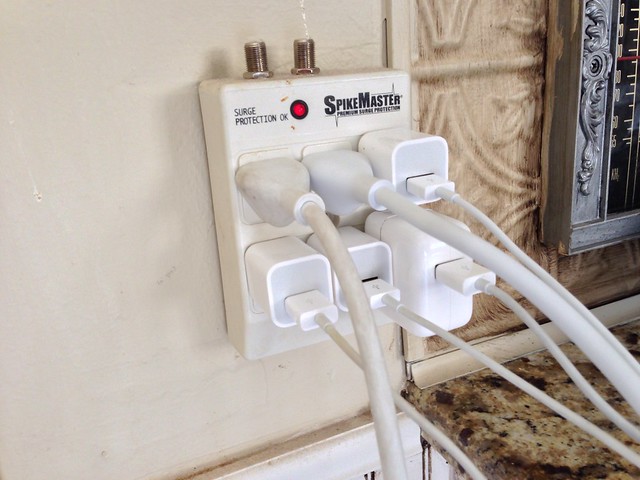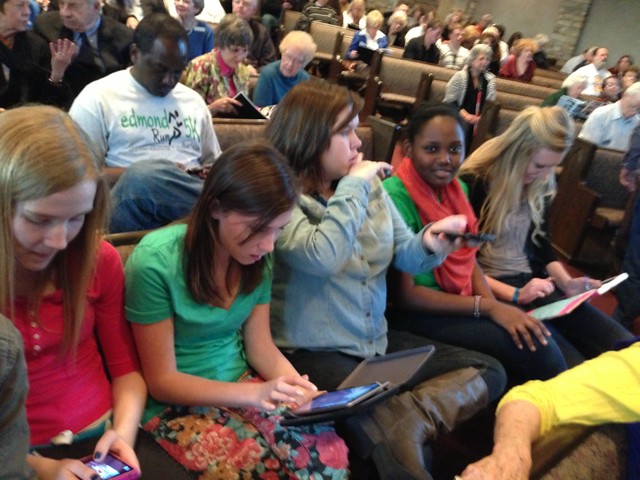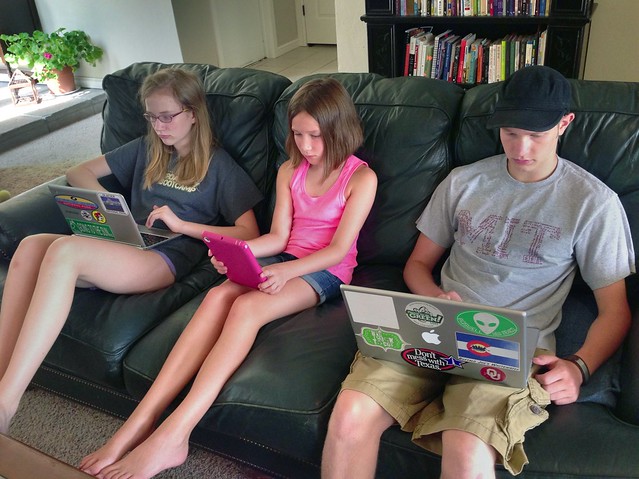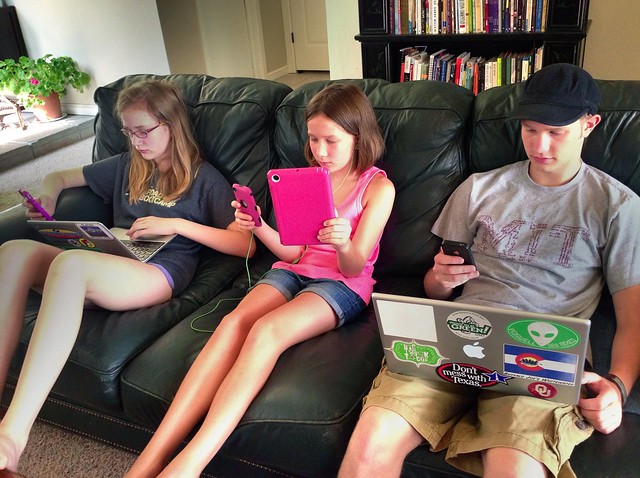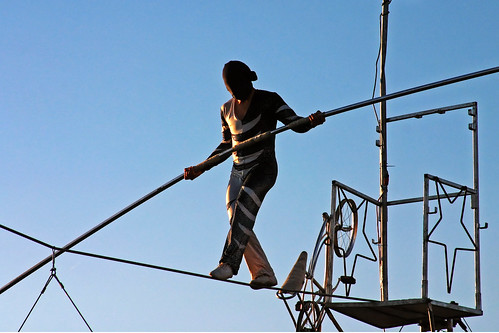Have you noticed a pattern of change with electrical plug usage in your kitchen and bedrooms at your house in the past few years?
The number of Internet-connected devices in the world is exploding, and this is visible in many households today via an increase in power chargers plugged into available outlets. In the past year, and especially this summer, I’ve noticed a clear pattern of behavior with our children. Left to their own devices, our kids will STAY connected to their devices more than is probably healthy for them.
This isn’t a new idea or observation, Marc Prensky has been talking at educational technology conferences for years about kids as “digital natives” and the irony of requiring students to “unplug” from our global communications grid when they step into disconnected classrooms where learning is largely OFFline. The challenges presented by proliferating devices and connectivity opportunities have become more personal in our family as our kids have gotten older, however. This summer, as our middle daughter turned 13 and (finally, from her point of view) got a Facebook account, has presented new opportunities for conversations. Other smartphone activities like watching TV via Netflix, text messaging, FaceTime videoconferencing, and Instagram photo sharing have also become more common in our house in the past year and led to more conversations about appropriate technology use.
Back in 2010, I took and shared the following photograph which I named, “The replacement for Saturday morning cartoons.”
Laptops are no longer the primary platform of choice for my kids these days, however, and this is not just happening in our family. In January I snapped this photograph before a congregational meeting at our church, when all the young people (and some older folks too) were on mobile devices.
These days when my kids (4th grade, 8th grade, and 10th grade) are working on homework, they sometimes use a larger, full-size laptop, but more often opt for a Chromebook or iPad. (As long as Minecraft is not involved!)
When I asked my kids to pose for the photo above this morning, however, I realized it wasn’t very realistic. More often than not, we (not just “the kids”) are on TWO devices at once when we’re at home engaged in some kind of digital work or play. Laptop or iPad in our laps, and a smartphone or iPod Touch in a hand.
While middle school teachers and students in the state of Maine have been “1 to 1” with laptops in the classroom and at home for 24/7 potential use for over a decade, many schools in my home state of Oklahoma are still debating whether to let students use their OWN devices at school. I don’t have the exact numbers, but out of over 500 public school districts in Oklahoma, I think we have less than 20 implementing 1:1 learning initiatives where students are allowed to take their devices home after the end of the school day. Contrast this to the state of Iowa, where over half of public districts will be 1:1 (according to that ‘device take-home’ definition) this year in 2013-2014.
To be realistic, in schools we need to talk about more than 1:1. Yes, public schools should PROVIDE a wireless, digital learning device for each student to utilize to both access as well as interactively create digital content. Schools should also accommodate and support a multi-device WiFi environment for learning too, however, since most “connected” adults today are not using a single device to communicate and get work done. We’re living in 2:1 and even 3:1 computing device environments.
I reflected on the value of family camping this summer “offline” in the July post, “Unplugging, Devices, Camping, Spades and Fairy Houses.” This week on Wednesday, when I shared the video “Goodnight iPad” with teachers in Bethany, Oklahoma, and contrasted it to the message in other compelling videos like “Cheryl and Morgan: Learning Independence,” I reflected on how important it is that we talk about the need to walk a tightrope together of too much or too little technology use. This is true in the classroom as well as at home.
Left to their own devices, students (and perhaps many older adults too) are likely to spend too much time on digital devices. When we do, we can miss out on important / needed face-to-face conversation opportunities. We also might focus more on CONSUMING content rather than CREATING media. Both can be fine, but like many things in life we need BALANCE.
These ideas continue to motivate me as I advocate for teachers to “Map Media to the Common Core.” The question I want more students and teachers asking every day in the classroom and out is, “What are we going to CREATE today?”
We might watch or read “Goodnight iPad” and become more energized with reactionary attitudes and thoughts about technology. “Just throw it all out” or “Just turn them all off” are common thoughts after experiencing the compelling message of Ayn Droid. Yet if we turn off all the wireless, digital devices in our classrooms or keep them out entirely, can we honestly say we’re helping our students learn to make good choices and become responsible citizens in our 21st century society? I don’t think so.
Providing access to technology today at home and in the classroom isn’t just about playing games, although that IS important too. Digital access is primarily about full participation in 21st century society. Yes, we may have a tendency to stay ON our devices too much. Balancing that tendency with an ability to voluntarily turn off our screens and go offline at times is a key element of learning self-control and self-discipline today. Learning those things has never been easy, but it’s always been important.
Increasing access to mobile devices and near-ubiquitous Internet access means we need “digital discipline” more than ever. For more about this, see my April 2007 post, “Need for digital discipline in SL and RL.” Those ideas still ring true today, six years later.
How are you helping your own children, students, and family workers (and yourself) practice more “digital discipline” in this context of “multiple device” access?
Technorati Tags: screen, screens, ipod, ipad, chromebook, laptop, edtech, technology, school, learning
If you enjoyed this post and found it useful, subscribe to Wes’ free newsletter. Check out Wes’ video tutorial library, “Playing with Media.” Information about more ways to learn with Dr. Wesley Fryer are available on wesfryer.com/after.
On this day..
- Choose Your Own Adventure YouTube Video: Lessons Learned – 2017
- Moving Students From Knowledgeable to Knowledge-ABLE: Michael Wesch at TEDxKC – 2014
- Help Shape the Vision of Oklahoma City Public Schools: Sunday August 4th – 2013
- Books on My Wish List Thanks to Bob Sprankle – 2012
- 12 Graphics to Illustrate Mapping Media to the Curriculum – 2012
- The phrase “CIPA compliant content” can be misleading – 2011
- iPad Apps for the classroom #blackfootETC – 2011
- Transformative Personal Connections in a Hyperconnected World #blackfootETC – 2011
- From 671 trains in a day to six: Transformations in travel and learning – 2010
- Show your remaining battery percentage on your iOS device (iPhone, iPad, etc) – 2010

